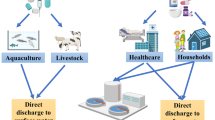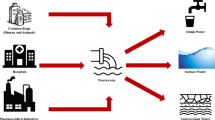Abstract
Purpose
Wetlands are a popular tool to treat/polish wastewater by reducing nutrient loading into the environment. In addition to nutrients, organic contaminants, such as pharmaceuticals and personal care products (PPCPs), are commonly detected in treated wastewater. Treatment wetlands may reduce concentrations of PPCPs before the treated effluent enters rivers and streams. Oxygen status may greatly affect the attenuation of PPCPs in wetland sediments by influencing microbial makeup and activity. An understanding of the effect of redox conditions on the degradation of PPCPs and the factors influencing PPCP sorption to wetland sediments is needed to maximize PPCP removal in treatment wetlands.
Materials and methods
Three wetland sediments from the San Diego Creek and Newport Bay watershed in Southern California, USA, were incubated under aerobic and anaerobic conditions to assess the degradation of several regularly occurring PPCPs and their phase distribution as a function of time.
Results and discussion
Under aerobic conditions, ibuprofen, N,N-diethyl-meta-toluamide (DEET), and gemfibrozil generally had half-life values around 20 days, while the half-life of carbamazepine was substantially longer (between 165 and 264 days). The anaerobic half-lives of gemfibrozil and ibuprofen increased by factors of 11–34 and carbamazepine increased by factors of 1.5–2.5. There was no detectable anaerobic degradation of DEET. The apparent phase distribution coefficient increased over time for DEET, carbamazepine and gemfibrozil, indicating that sorption of PPCPs to wetland sediments may be more limited than that predicted using equilibrium sorption coefficient values.
Conclusions
Knowledge of the capacity of wetland sediments for degrading and sorbing PPCPs is vital to the design of treatment wetlands. Degradation of the selected PPCPs was enhanced under aerobic conditions as compared to anaerobic conditions. Sorption to sediments increased with contact time, indicating that longer hydraulic retention will increase wetland capabilities for removing PPCPs.


Similar content being viewed by others
References
Alexander M (2000) Aging, bioavailability, and overestimation of risk from environmental pollutants. Environ Sci Technol 34:4259–4265
Araujo L, Villa N, Camargo N, Bustos M, Garcia T, Prieto AD (2011) Persistence of gemfibrozil, naproxen and mefenamic acid in natural waters. Environ Chem Lett 9:13–18
Benotti MJ, Brownawell BJ (2009) Microbial degradation of pharmaceuticals in estuarine and coastal seawater. Environ Pollut 157:994–1002
Bondarenko S, Gan JY (2004) Degradation and sorption of selected organophosphate and carbamate insecticides in urban stream sediments. Environ Toxicol Chem 23:1809–1814
Brooks BW, Huggett DB, Boxall ABA (2009) Pharmaceutical and personal care products: research needs for the next decade. Environ Toxicol Chem 28:2469–2472
Buth JM, Steen PO, Sueper C, Blumentritt D, Vikesland PJ, Arnold WA, McNeill K (2010) Dioxin photoproducts of triclosan and its chlorinated derivatives in sediment cores. Environ Sci Technol 44:4545–4551
Chambers DB, Leiker TJ (2006) A reconnaissance for emerging contaminant in the South Branch Potomac River, Cacapon River and Williams River basins, West Virginia, April–October 2004. USGS Open File Report 2006–1393
Clarke BO, Porter NA, Symons RK, Marriott PJ, Stevenson GJ, Blackbeard JR (2010) Investigating the distribution of polybrominated diphenyl ethers through an Australian wastewater treatment plant. Sci Total Environ 408:1604–1611
Conkle JL, White JR, Metcalfe CD (2008) Reduction of pharmaceutically active compounds by a lagoon wetland wastewater treatment system in Southeast Louisiana. Chemosphere 73:1741–1748
Conkle JL, Lattao C, White JR, Cook RL (2010) Competitive sorption and desorption behavior for three fluoroquinolone antibiotics in a wastewater treatment wetland soil. Chemosphere 80:1353–1359
Day JW, Ko J-Y, Rybczyk J, Sabins D, Bean R, Berthelot G, Brantley C, Cardoch L, Conner W, Day JN, Englande AJ, Feagley S, Hyfield E, Lane R, Lindsey J, Mistich J, Reyes E, Twilley R (2004) The use of wetlands in the Mississippi Delta for wastewater assimilation: a review. Ocean Coast Manag 47:671–691
Drillia P, Stamatelatou K, Lyberatos G (2005) Fate and mobility of pharmaceuticals in solid matrices. Chemosphere 60:1034–1044
Heberer T, Reddersen K, Mechlinski A (2002) From municipal sewage to drinking water: fate and removal of pharmaceutical residues in the aquatic environment in urban areas. Water Sci Technol 46:81–88
Jobling S, Nolan M, Tyler CR, Brighty G, Sumpter JP (1998) Widespread sexual disruption in wild fish. Environ Sci Technol 32:2498–2506
Kasprzyk-Hordern B, Dinsdale RM, Guwy AJ (2009) The removal of pharmaceuticals, personal care products, endocrine disruptors and illicit drugs during wastewater treatment and its impact on the quality of receiving waters. Water Res 43:363–380
Kunkel U, Radke M (2008) Biodegradation of acidic pharmaceuticals in bed sediments: insight from a laboratory experiment. Environ Sci Technol 42:7273–7279
Lin KD, Gan J (2011) Sorption and degradation of wastewater-associated non-steroidal anti-inflammatory drugs and antibiotics in soils. Chemosphere 83:240–246
Lin AY-C, Plumlee MH, Reinhard M (2006) Natural attenuation of pharmaceuticals and alkylphenol polyethoxylate metabolites during river transport: photochemical and biological transformation. Environ Toxicol Chem 25:1458–1464
Lin K, Haver D, Oki L, Gan J (2008) Transformation and sorption of fipronil in urban stream sediments. J Agric Food Chem 56:8594–8600
Lin KD, Bondarenko S, Gan J (2011) Sorption and persistence of wastewater-borne psychoactive and antilipidemic drugs in soils. J Soils Sediments 11:1363–1372
Matamoros V, Arias C, Brix H, Bayona JM (2007) Removal of pharmaceuticals and personal care products (PPCPs) from urban wastewater in a pilot vertical flow constructed wetland and a sand filter. Environ Sci Technol 41:8171–8177
Matamoros V, Garcia J, Bayona JM (2008) Organic micropollutant removal in a full-scale surface flow constructed wetland fed with secondary effluent. Water Res 42:653–660
Matamoros V, Hijosa M, Bayona JM (2009a) Assessment of the pharmaceutical active compounds removal in wastewater treatment systems at enantiomeric level. Ibuprofen and naproxen. Chemosphere 75:200–205
Matamoros V, Duhec A, Albaiges J, Bayona JM (2009b) Photodegradation of carbamazepine, ibuprofen, ketoprofen and 17 alpha-ethinylestradiol in fresh and seawater. Water Air Soil Pollut 196:161–168
Matamoros V, Jover E, Bayona JM (2010) Occurrence and fate of benzothiazoles and benzotriazoles in constructed wetlands. Water Sci Technol 61:191–198
Patterson BM, Shackleton M, Furness AJ, Pearce J, Descourvieres C, Linge KL, Busetti F, Spadek T (2010) Fate of nine recycled water trace organic contaminants and metal(loid)s during managed aquifer recharge into a anaerobic aquifer: column studies. Water Res 44:1471–1481
Quinn B, Gagne F, Blaise C (2009) Evaluation of the acute, chronic and teratogenic effects of a mixture of eleven pharmaceuticals on the cnidarian, Hydra attenuata. Sci Total Environ 407:1072–1079
Rabenhorst MC, Megonigal JP, Keller J (2010) Synthetic iron oxides for documenting sulfide in marsh pore water. Soil Sci Soc Am J 74:1383–1388
Robinson AA, Belden JB, Lydy MJ (2005) Toxicity of fluoroquinolone antibiotics to aquatic organisms. Environ Toxicol Chem 24:423–430
Scheytt T, Mersmann P, Lindstadt R, Heberer T (2005) Determination of sorption coefficients of pharmaceutically active substances carbamazepine, diclofenac, and ibuprofen, in sandy sediments. Chemosphere 60:245–253
Stein K, Ramil M, Fink G, Sander M, Ternes TA (2008) Analysis and sorption of psychoactive drugs onto sediment. Environ Sci Technol 42:6415–6423
Tappe WG, Zarfl C, Kummer S, Burauel P, Vereecken H, Groeneweg J (2008) Growth-inhibitory effects of sulfonamides at different pH: dissimilar susceptibility patterns of a soil bacterium and a test bacterium used for antibiotic assays. Chemosphere 72:836–843
United Stated Environmental Protection Agency (2007) Method 1694: pharmaceutical and personal care products in water, soil, sediment and biosolids by HPLC/MS/MS. EPA-821-4-08-002. USPEA, Washington DC, USA
Vanderford BJ, Snyder SA (2006) Analysis of pharmaceuticals in water by isotope dilution liquid chromatography/tandem mass spectrometry. Environ Sci Technol 40:7312–7320
Walters E, McClellan K, Halden RU (2010) Occurrence and loss over three years of 72 pharmaceuticals and personal care products from biosolids–soil mixtures in outdoor mesocosms. Water Res 44:6011–6020
Webb S, Ternes T, Gibert M, Olejniczak K (2003) Indirect human exposure to pharmaceuticals via drinking water. Toxicol Lett 142:157–167
White JR, Belmont M, Metcalfe C (2006) Pharmaceutical compounds in wastewater: wetland treatment as a potential solution. Sci World J 6:1731–1736
Yamamoto H, Nakamura Y, Moriguchi S, Honda Y, Tamura I, Hirata Y, Hayashi A, Sekizawa J (2009) Persistence and partitioning of eight selected pharmaceuticals in the aquatic environment: laboratory photolysis, biodegradation, and sorption experiments. Water Res 43:351–362
Yu Y, Wu LS (2011) Comparison of four extraction methods for the analysis of pharmaceuticals in wastewater. J Chromatogr A 1218:2483–2489
Acknowledgments
This project was funded the USDA-NIFA Award Notification 2011-67019-21120 “Understanding Fate of PPCPs in Soil-Plant Systems Irrigated with Treated Wastewater”. Thanks to Andy Lu and Katie Thomason for their assistance in sample preparation.
Author information
Authors and Affiliations
Corresponding author
Additional information
Responsible editor: Jan Schwarzbauer
Electronic supplementary material
Below is the link to the electronic supplementary material.
ESM 1
DOCX 43 kb
Rights and permissions
About this article
Cite this article
Conkle, J.L., Gan, J. & Anderson, M.A. Degradation and sorption of commonly detected PPCPs in wetland sediments under aerobic and anaerobic conditions. J Soils Sediments 12, 1164–1173 (2012). https://doi.org/10.1007/s11368-012-0535-8
Received:
Accepted:
Published:
Issue Date:
DOI: https://doi.org/10.1007/s11368-012-0535-8




